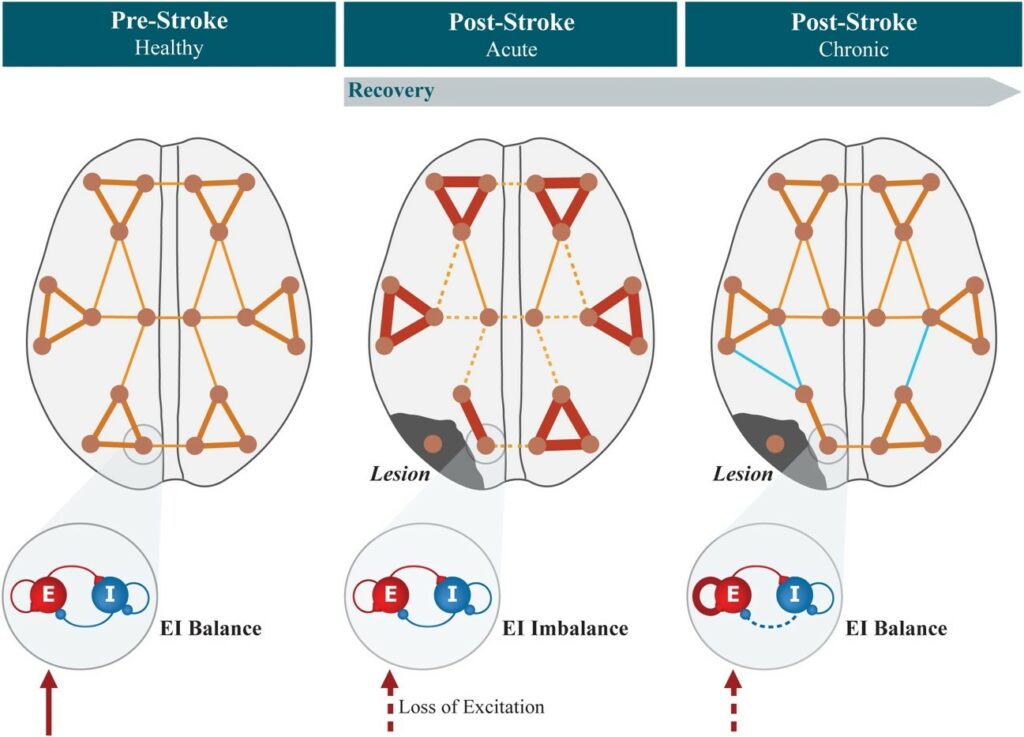30.03.2022. The mechanisms by which focal brain lesions such as stroke affect brain areas away from the lesion, causing a wide loss of functional activity ranging from motor to cognitive function, are not completely understood and are still unresolved.
In the early 20th-century, new mechanisms were being explored on neural excitability and large-scale cortical dynamics, and the concept of Diaschisis was defined as changes in excitability affecting the local excitatory-inhibitory (EI) balance of distant brain networks. This alone was insufficient to explain the functional symptoms derived from stroke, thus suggesting that remote disruptions in functional connectivity (FC) are also a relevant aspect of the process.
A recent review paper by Francisco Dos Santos and Paul Verschure (SPECS-lab) summarizes the main findings related to Diaschisis for both functional connectivity (FC) and excitatory-inhibitory balance (EI) and the link of long-term changes to cortical plasticity mechanisms after brain injury.
“…changes in excitability correlated positively with stroke patient’ motor recovery, suggesting that regulation of EI balance as a part of the process of functional recovery.”
In this review paper, the authors highlight the main findings on the evolution of excitability and functional cortical networks during post-stroke recovery and how they are related to functional recovery. The authors also show that cortical reorganization at a global scale can be explained from the perspective of excitatory-inhibitory homeostasis since the recovery of functional networks is paralleled by increases in excitability across the cortex.
In addition, the work by Dos Santos and Verschure summarizes the recent advances in computational modeling of stroke, proposing modeling as a framework for the study of the concurrent evolution of Functional Connectivity and excitability in the post-stroke brain. Figure 1 summarizes the evolution of connectivity and local EI balance in cortical networks after stroke.

Figure 1. Summary of the evolution of connectivity and local EI balance in cortical networks after stroke. In the healthy brain, functional networks show a modular structure, with strongly connected regions forming modules connected by functional hubs. Excitatory and inhibitory synapses are regulated locally by EI homeostasis so that balance is maintained, accounting for the level of excitation received from external sources and keeping neuronal firing rates stable. Focal lesions experienced by stroke patients lead to neural tissue necrosis in confined areas. In the acute period after lesion, the modular organization of functional networks is disrupted, showing increased segregation between modules, together with decreased interhemispheric and increased intrahemispheric connectivity. Simultaneously, areas that previously received white matter projections from the lesioned region experience a sudden reduction in the levels of external excitation, causing a local imbalance in excitatory and inhibitory activity. During the process of recovery, synaptic plasticity compensates for the reduced excitation by increasing/decreasing the strength of excitatory/inhibitory synapses unto pyramidal neurons, increasing their excitability to restore local EI balance. Concurrently, functional connectivity changes toward pre-lesion levels, either through the recovery of healthy functional networks or via cortical reorganization and the formation of new functional pathways (represented in light blue).
Understanding diaschisis and the interaction between excitatory homeostasis and functional connectivity may be the key to understanding the cortical activity in the healthy and non-healthy brain. Importantly, computational modeling of this interaction can provide a controllable and manipulable framework to study neurological disorders. In the case of stroke, large-scale computational models of cortical activity would then allow the study of simultaneous changes in excitability and functional connectivity, thus predicting a range of side effects as in stroke. These models may be useful for designing and developing more efficient and personalized therapies, thus improving rehabilitation procedures for stroke patients.
“The localized nature of stroke lesions provides a framework to advance our understanding of cortical function, both at regional and network levels, clarifying how behavioral and cognitive functions emerge from the local and global properties of cortical activity”.
The authors discussed the results of this paper in a short interview at https://www.youtube.com/watch?v=J0UyRHLopXs&ab_channel=ConvergentScienceNetwork
These findings are part of the research program by the SPECS-lab led by Professor Paul Verschure.
Dos Santos, F. P., & Verschure, P. F. (2021). Excitatory-Inhibitory Homeostasis and Diaschisis: Tying the Local and Global Scales in the Post-stroke Cortex. Frontiers in Systems Neuroscience, 15.
This work was supported by the EU projects ReHyb (H2020—ID 871767), euSNN (MSCA-ITN-ETN H2020—ID 860563), Virtual Brain Cloud (H2020 ID 826421), RGS@HOME (H2020—EIT Health—ID 19277).